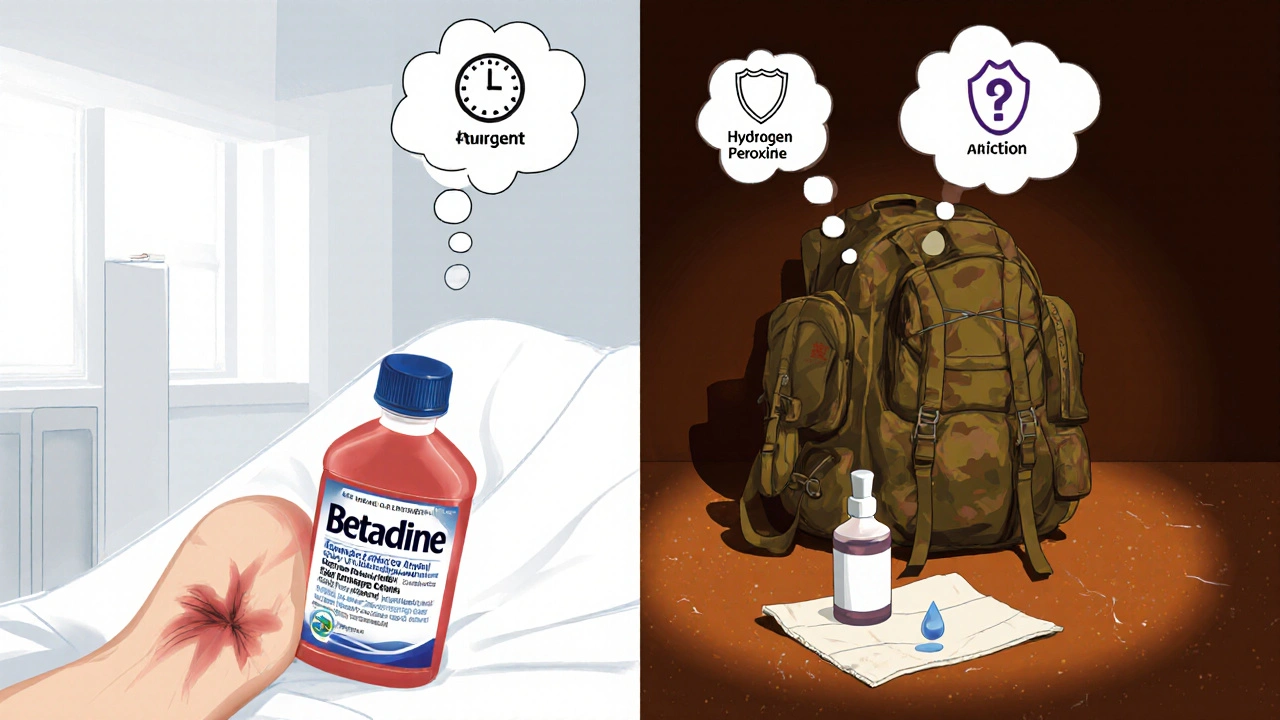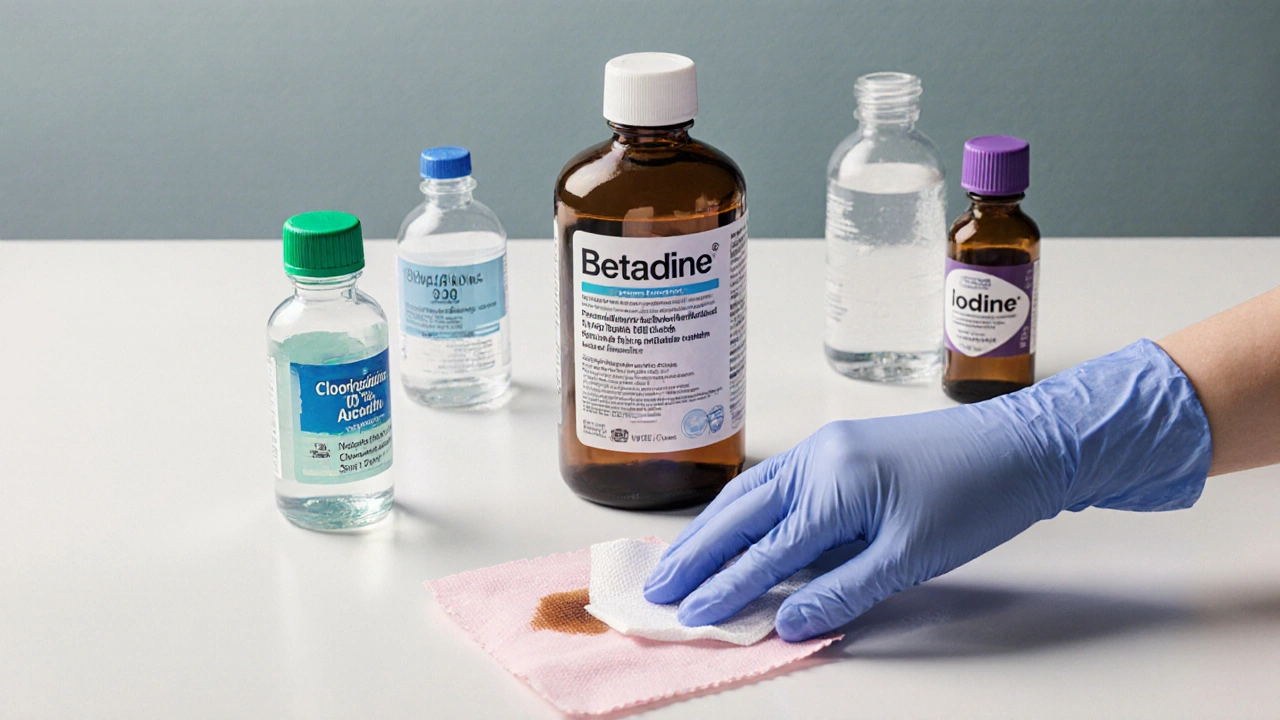Antiseptic Selector Tool
Recommended Antiseptic
Why This Choice?
Comparison Summary
Key Strengths
Potential Drawbacks
When you need to keep a cut clean or prep skin before a medical procedure, the first thing that comes to mind is often a familiar bottle of Betadine. But is it always the best choice? This guide breaks down Betadine’s properties, stacks it against common alternatives, and helps you decide which antiseptic fits your situation.
What is Betadine (Povidone Iodine)?
Betadine is a brand name for a water‑soluble complex of elemental iodine and povidone (polyvinylpyrrolidone). The formulation releases free iodine when it contacts skin, delivering a broad‑spectrum antimicrobial effect. First introduced in the 1950s, Betadine quickly became a staple in hospitals because it works against bacteria, viruses, fungi, and protozoa.
How Betadine Works
The iodine in Betadine penetrates microbial cell walls and oxidizes proteins, nucleic acids, and fatty acids. This oxidative damage halts essential cellular functions, leading to rapid cell death. Because iodine targets multiple structures, microbes find it hard to develop resistance.
Common Antiseptic Alternatives
Below are the most frequently used rivals, each with a unique chemistry and usage profile.
Chlorhexidine is a cationic bisbiguanide that disrupts cell membranes, especially of gram‑positive bacteria. It’s favored for pre‑operative skin prep because it leaves a lingering antibacterial film.
Hydrogen peroxide is a 3% aqueous solution that releases oxygen radicals, mechanically blowing away debris and oxidizing microbial components.
Isopropyl alcohol (typically 70% concentration) works by denaturing proteins and dissolving lipid membranes, offering fast‑acting disinfection.
Iodine tincture combines elemental iodine with ethanol and a small amount of potassium iodide, delivering a potent but more irritating antiseptic solution.
Normal saline (0.9% sodium chloride) is not an antiseptic but is often used to irrigate wounds before applying an antimicrobial agent.

Side‑Effect Profile of Each Antiseptic
Understanding potential irritation helps avoid complications.
- Betadine: Can cause temporary skin staining, mild irritation, and rare iodine allergy.
- Chlorhexidine: May trigger contact dermatitis in sensitive individuals; rare anaphylaxis reported.
- Hydrogen peroxide: Causes bubbling, which can be painful; repeated use may impair fibroblast activity.
- Isopropyl alcohol: Highly drying; can sting open wounds and damage surrounding tissue.
- Iodine tincture: Strong odor, higher risk of dermatitis, especially on compromised skin.
Performance Comparison
| Antiseptic | Spectrum | On‑set Action | Residue / Duration | Typical Use Cases | Common Side Effects |
|---|---|---|---|---|---|
| Betadine | Broad (bacteria, viruses, fungi, protozoa) | 30-60seconds | Leaves iodine film for ~10min | Wound cleaning, surgical prep, burns | Staining, iodine allergy, mild irritation |
| Chlorhexidine | Strong against gram‑positive, moderate gram‑negative | ~30seconds | Persistent antibacterial effect up to 6h | Pre‑op skin prep, catheter sites | Contact dermatitis, rare anaphylaxis |
| Hydrogen peroxide | Broad but less effective vs spores | Immediate (bubble formation) | No lasting residue | First‑aid cleaning, oral rinses | Bleaching, delayed wound healing |
| Isopropyl alcohol | Broad (except bacterial spores) | Immediate | Evaporates in seconds | Skin disinfection, tool sterilization | Dryness, sting, possible tissue necrosis |
| Iodine tincture | Broad, similar to Betadine | 30-45seconds | Short‑lived; ethanol evaporates quickly | Minor cuts, animal bites | Strong odor, higher dermatitis risk |
Decision‑Making Checklist
Use this quick cheat sheet to match the antiseptic to your scenario.
- Is the wound deep or involving bone? Prefer Betadine for its broad spectrum and sustained action.
- Need a long‑lasting barrier? Choose Chlorhexidine for its residual effect.
- Concerned about staining or iodine allergy? Opt for Isopropyl alcohol or Hydrogen peroxide, but avoid open wounds that need moisture.
- Working in a resource‑limited setting? Hydrogen peroxide or Iodine tincture are cheap and widely available.
- Patient has a known iodine or chlorhexidine allergy? Use alcohol‑based or saline irrigation followed by a non‑iodine antiseptic like Hydrogen peroxide.

Practical Application Tips
- Always clean the wound with sterile saline before applying any antiseptic. Saline won’t kill microbes, but it removes debris that can shield them.
- Apply antiseptic using a sterile gauze pad, covering the entire wound surface. For Betadine, let it sit for at least 30seconds before rinsing if excess staining is a concern.
- Do not reuse gauze pads; re‑application can introduce new contaminants.
- For surgical prep, use the antiseptic in a concentric wiping pattern-from the incision center outward-to avoid spreading microbes.
- Store solutions in a cool, dark place. Iodine degrades with light, reducing effectiveness over time.
When to Seek Professional Care
If a wound shows signs of deep infection-redness spreading beyond 2cm, increasing pain, pus, fever-or if you have underlying conditions like diabetes, consult a healthcare provider regardless of the antiseptic used.
Frequently Asked Questions
Can I use Betadine on a child’s minor cut?
Yes. Betadine is safe for children over 2months, but limit exposure to the eye area and watch for any skin reaction.
Is chlorhexidine better than Betadine for surgical skin prep?
Many studies show chlorhexidine’s residual activity reduces postoperative infection rates compared to a single Betadine rinse, especially in orthopedic procedures. However, Betadine remains effective when a rapid, broad spectrum is needed.
Can hydrogen peroxide delay wound healing?
Repeated use can impair fibroblast proliferation, potentially slowing closure. Use it once for initial cleaning, then switch to a gentler antiseptic like Betadine or saline.
What should I do if I develop a rash after using Betadine?
Stop using the product immediately, rinse the area with saline, and apply a hypoallergenic moisturizer. If the rash worsens or spreads, seek medical advice.
Is alcohol safe for deep puncture wounds?
Alcohol can be too harsh for deep tissue; it may cause necrosis and increase pain. Prefer Betadine or chlorhexidine, which are gentler on underlying structures.
Choosing the right antiseptic isn’t a one‑size‑fits‑all decision. By weighing spectrum, duration, irritation potential, and the specific wound context, you can pick the option that keeps infections at bay while supporting healing.


Written by Felix Greendale
View all posts by: Felix Greendale